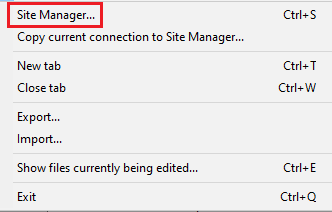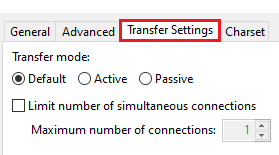When using a FileZilla server, encountering connectivity issues can be frustrating, especially if you cannot establish a connection.
The ‘Can’t Connect to FileZilla Server’ error is a common issue that users often face. In this detailed guide, we will walk through the solutions for troubleshooting and resolve this error effectively.
Let’s get started!
Also Read: Correct Method to Use FTPS in FileZilla for a Secure FTP Access
Solutions to Fix the Error Can’t Connect to FileZilla Server
1. Verify Connection Settings
➢ Issue: Sometimes, it happens that the credentials or any other details you are entering in Filezilla are wrong.
★ Solution: You have to ensure that the host IP you entered is correct. Also, you have to check the user & password you entered. There is a chance that copy-paste doesn’t work sometimes. You can try by typing the password.
If the above solution doesn’t work, you can try limiting simultaneous connections.
2. Limiting Simultaneous Connections
➢ Issue: Too many simultaneous connections can overwhelm the FTP server, leading to connection failures.
★ Solution: You have to limit the number of concurrent connections in FileZilla.
To limit connections in FileZilla, here are the steps to achieve this:
➔ Open FileZilla Server Interface

➔ Navigate to ‘File’ in the menu & click on it.
![]()
➔ In that, open ‘Site Manager’

➔ A new box will open. In that, navigate to ‘Transfer Settings’

➔ Check the box ‘Limit number of simultaneous connections’

➔ An edit option will be available. You have to enter the maximum number of simultaneous connections allowed from a single IP address

➔ Note: We recommend keeping a maximum of 2 connections allowed.
➔ Once done, click ‘OK’ to save the changes.

If the problem still persists, you can use an FTP prefix before your domain name!
Also Read: How to Backup a Website Using Filezilla?
3. Using an FTP Hostname Prefix
➢ Issue: Services like Sitelock or Sucuri may require an ‘ftp.’ prefix for successful connections.
★ Solution: Modify your FTP hostname in FileZilla by adding ‘ftp.’ before the domain name.
If the issue is still unresolved, you have to check the firewall & antivirus settings.
4. Checking Firewall and Antivirus Settings
➢ Issue: Firewalls or antivirus programs may block FTP/SFTP connections.
★ Solution: Verify and adjust firewall and antivirus settings to ensure they allow FTP/SFTP connections. You have to make sure that the usual FTP ports, like 21 and 22, are open and available for connecting
Does the issue still exist? You have to set the transfer mode to a passive connection.
5. Setting Transfer Mode to ‘Passive’
➢ Issue: Active mode connections may face firewall-related problems.
★ Solution: Switch to passive mode in FileZilla for more firewall-friendly and successful connections.
To set the transfer mode to Passive, below are the steps for this:
➔ In the FileZilla Server Interface, head to ‘File’ in the menu & click on it.
![]()
➔ In that, click on ‘Site Manager’

➔ A new popup box will open. In that, navigate to ‘Transfer Settings’

➔ In the ‘Transfer mode’, click on ‘Passive’
![]()
➔ Once done, click ‘Ok’ to save the changes.

Also Read: Simple Steps To Add Private Key in Filezilla For SFTP
These solutions address common issues that trigger the “Can’t Connect to FileZilla Server” error. Depending on your specific scenario, implementing one or a combination of these fixes should resolve the connectivity problem.
Passing through connection issues in FileZilla can be challenging, but with the right troubleshooting steps, you can overcome the “Can’t Connect to FileZilla Server” error. Whether it’s adjusting simultaneous connection limits, configuring firewall settings, or making changes to connection modes, these solutions empower you to establish a stable and reliable connection for seamless file transfers.
By understanding and implementing these solutions, you can make your FileZilla experience smoother, ensuring efficient communication between your local machine and remote server. If you encounter persistent issues or need further assistance, reaching out to your hosting provider or server administrators can provide additional support.
In conclusion, troubleshooting connection errors in FileZilla is a vital skill for anyone involved in file transfers. The solutions outlined here empower users to resolve common issues, allowing them to harness the full potential of FileZilla’s capabilities.
